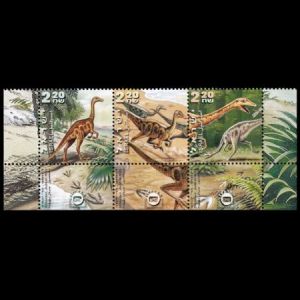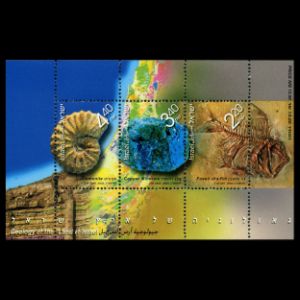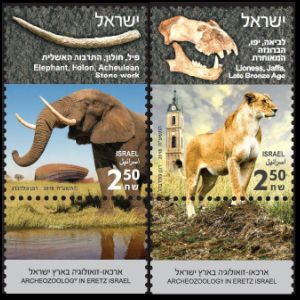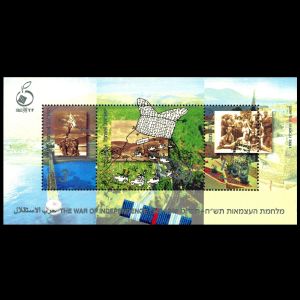the place where Paleontology and Paleoanthropology meets Philately
Israel
Dinosaur and its footprints, fossils and fossil-found places on stamps and postmarks of Israel
| << previous country | back to index | next country >> |
Contents:
- Country overview
- Philately of Israel
- Official stamps of the Israel related to Paleontology
- Other stamps of Israel to consider
- Stamps that looks like Paleontology but it is not
- Commemorative postmarks of Israel related to Paleontology
- References
- Acknowledgements
Israel, officially known as the State of Israel is a country in the Middle East, on the southeastern shore of the Mediterranean Sea and the northern shore of the Red Sea. It has land borders with Lebanon to the north, Syria to the northeast, Jordan on the east, respectively, and Egypt to the southwest. It contains geographically diverse features within its relatively small area.
Following World War II, the British withdrew from their mandate of Palestine, and the UN partitioned the area into Arab and Jewish states, an arrangement rejected by the Arabs. Subsequently, the Israelis defeated the Arabs in a series of wars without ending the deep tensions between the two sides. Israel's financial center and technology hub is Tel Aviv. Jerusalem is the proclaimed capital. [R1]
The State of Israel has published postage stamps since gaining independence on May 14, 1948. The first postage stamps were issued two days later on May 16, 1948. [R2]
Official stamps of Israel related to Paleontology: dinosaurs and prehistoric animals, fossils
| 05.12.2000 "Dinosaur of Judean Hills" | 18.06.2002 "Geology of the land of Israel" | 28.08.2018 "Archeozoology in Eretz Israel" |
 |
 |
 |
Other stamps to consider: fossil found places, flint tools
| 05.04.1994 "Saul Adler" [A3] | 11.02.2014 "Makhtesh Ancient Erosion in Israel" [A1] | 07.02.2017 "UNESCO world heritage" [A2] |
 |
 |
 |
Notes:
 |
 |
| Landscape of Makhtesh Ramon on stamp of Israel 2014, MiNr.: 2399, Scott: 2005. | Fossils of Makhtesh Ramon on the cachet of FDC of Israel 2014, |
Makhtesh Ramon, located near Mitzpe Ramon, is a geological feature of Israel's Negev desert. Located at the peak of Mount Negev, some 85 km south of the city of Beersheba, the landform is not an impact crater from a meteor nor a volcanic crater formed by a volcanic eruption, but rather is the world's largest "erosion cirque" The formation is 40 km long, 2–10 km wide and 500 meters deep, and is shaped like an elongated heart.
Makhtesh – Ancient Erosion Craters in Israel
The dynamic earth has formed almost unique geological landforms in the Negev desert.
Initially, a layered sequence of hard limestone and dolomite rocks was deposited over softer sandstone sediments.
The sequence was folded into asymmetric folds, producing four parallel, northeast - southwest, topographical ridges.
An erosion surface removed the hard limestone and dolomite rocks of the fold’s crest, exposing the underlying friable sandstone,
which was eroded, forming a deep transverse valley.
The creeks drain into the Dead Sea - Arava valley, through a single outlet, incised into the southeastern flank.
The closed valleys are surrounded by steep cliffs, 200–400 m high.
A This type of breached valley or erosion crater of this sort is known as a “makhtesh”.
A makhtesh is a “geological window”, through which the ancient strata are revealed.
A makhtesh contains a variety of different colored rocks, and diverse fauna and flora.
Makhtesh Ramon is a geologist's paradise with fossils, rock formations and volcanic and magmatic phenomenon
dating back as much as 220 million years.
The Ramon crater began forming when the ocean that covered the desert began to move north.
The geological map of Makhtesh Ramon area is illustrated on the first day cover
of "Geology of the land of Israel" stamps from 2002.
It has been designated as a national geological park.
Many fossils were historically unearthed from the north-eastern edge of the crater.
These fossils included ammonoids, shark teeth, and petrified wood.
Some of these fossils are depicted on the illustration of the FDC.
[R3]
[A2] Three stamps showing UNESCO world heritage sites of Israel. One of them depicting a beautiful prehistoric stone tool from Nahal Mearot Caves in Israel.
Four caves (Tabun, Gamal Nahal and Es-Skhul Cave)
are carved into the mountain on the southern slope
of Mount Carmel, at the entrance to the Nahal Me'arot Caves.
Archeological excavations conducted at the site from 1928 to the
present have discovered evidence of human existence near and inside the
caves over hundreds of thousands of years.
Among the many findings were remnants of houses, various stone tools, jewelry,
bones of animals used for food and graves.

|
| Flint tool on stamp of Israel 2017 MiNr.: 2553, Scott: |
The findings have led archeologists to believe the two sub-species found harmony in a coastal mountain range that today is in a state of war with its neighbours. None of the bones uncovered at Nahal Me'arot - a World Heritage site - had lethal wounds which suggested prehistoric men lived in peace with each other 80,000 years ago. [R4]
[A3] Saul Adler (1895-1966), was one of Israel's most outstanding scientists and his scientific contributions in a number of fields earned him wide international recognition.
Adler specialized in tropical medicine. In 1924 he was appointed as a research fellow at the Hebrew University, became Professor in 1928 and was a Head of the Department of Parasitology until his retirement in 1965.
In addition to his great scientific knowledge, he was a Hebrew and Yiddish scholar and was as much at home with Elizabethan poetry as with classical and modern Hebrew literature. He was an inquiring and enthusiastic student of natural history, and a mathematician of considerable ability.
Adler's translation of Darwin's Origin of Species into Hebrew was awarded the Tchernichowsky Prize. [R7]
Stamps that appear to be paleontology-related, but they are not
| 17.02.1998 "50 years since the War of Independence" [NP1] | ||
 |
 |
|
Notes:
[NP1] In February 1998, Post Authority of Israel issued a set of three stamps "50 years since the War of Independence".
The stamps were issued as separate sheets and in one common mini-sheet. These stamps represent the three battle fronts of Israel:
- the central front, represented by the battles at the Castel, on the outskirts of Jerusalem, between the 2nd and 9th of April 1948
- the northern front, represented by the battle for Zefat and liberation of the Jewish quarter in Zefat in May 1948
- the southern front represented by the raising of the Israeli flag in Eilat on March 10th, 1949, marking the termination of combat in the War of Independence.
If you look closely at the margin of the mini-sheet to the right of the Zefat stamp, a sketch of a mounted skeleton of a dinosaur is present in the bottom right margin.

|
| Dinosaur sculpture in old city of Zefat, created by Israeli artist Arik Amir. Image credit: arik-amir.com |

|
| Dinosaur on stamp of Israel 1998 "50th Anniversary of Independence War", MiNr.: 1425l, Scott: 1325 |
Zefat, sometime written as Tsfat or Sefat, is a small city with population of 30.000. Since the 16th century, Zefat has been considered one of Judaism's Four Holy Cities, along with Jerusalem, Hebron and Tiberias; since that time, the city has remained a centre of Kabbalah, also known as Jewish mysticism.
There are only a few museums in the city, none of which focus on natural history.
In addition to its title as the city of Kabbalah, Safed is also known as a city of art. Many creative souls are attracted to and inspired by the winding, narrow, cobblestone streets of Safed's Old City, home to a bustling artists' quarter. Many small and mid-size art galleries are located in the old-city.
One of the galleries belongs to Arik Amir, who is also known as "Arik the Animal Mimic" and "Arik the Sculptor", who was born in Tel Aviv in 1922.
In 1965 he purchased a ruined building in the artists' colony in the enchanted city of Zefat, which he renovated and called it "God's Little Acre". During the schools' summer vacation, he commenced sculpting in iron, creating hundreds of sculptures. His home, "God's Little Acre" became a gallery with a permanent display of his works, and thousands of visitors from Israel and all over the world flocked to see it.
In the early 1980's, he produced many modern and fantastic animal iron sculptures. One of the biggest sculptures he made is 8m high stylized dinosaur, which stood outside of his gallery and attracted many visitors to the gallery.
The iron-dinosaur appeared in newspapers and some postcards issued this time. Perhaps, the stamp designer used one of these cards as a source for his work.
Unfortunately, the dinosaur on the stamp is just an art object, not a fossil and does not represent any known species.
Commemorative postmarks of Israel related to Paleontology
Legend is here| 05.12.2000 "Dinosaur, Judean Hills" [FDC] | 28.08.2018 "Archeozoology in Eretz Israel" [FDC] | |
 |
 |
|
References:
- [R1] Israel: Wikipedia, WikiTravel, FlagCounter.
- [R2] Postal History and Philately of Israel:
Wikipedia,
Shamir Brothers,
Links to official website of the Post Authority, stamp catalog and a list of new stamps of Israel are here - [R3] Makhtesh Ramon: Wikipedia, Academia.edu,
- [R4] Nahal Mearot Caves in Israel: Dailymail (Neanderthals and human lived side by side in Middle Eastern caves and even interbred, research finds).
- [R6] Dinosaur sculpture in old city of Zefat: Zefat (Wikipedia), Art Gallery of Arik Amir.
- [R7] Saul Adler: Israel Philatelic Federation.
Acknowledgement:
- Many thanks to Dr. Eli Moallem from Jerusalem, Israel, for his help finding information about the dinosaur sculpture on the “50 years since the War of Independence” stamps.
- Many thanks to Dr. Peter Voice from Department of Geological and Environmental Sciences, Western Michigan University, for the draft page review and his valuable comments.
| << previous country | back to index | next country >> |